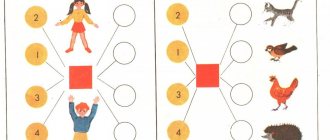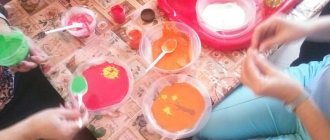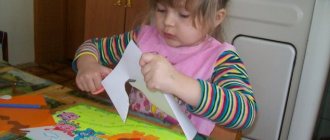Master class for teachers using socio-game technologies “City Street”
Bibliographic description:
Sokolova, O. V. Master class for teachers using socio-game technologies “City Street” / O. V. Sokolova. — Text: direct // Questions of preschool pedagogy. - 2022. - No. 3 (9). — P. 68-71. — URL: https://moluch.ru/th/1/archive/63/2563/ (access date: 01/03/2022).
Keywords: social gaming technologies, messenger, team, interaction
Target:
− increasing the professional skills of teachers in the process of active pedagogical communication to develop work experience in the use of socio-game technology in working with preschoolers. Building effective team interaction.
Tasks:
- To form an idea among teachers about the possibilities of using socio-game technology in organizing the educational process in accordance with the Federal State Educational Standard;
- Teach the techniques of social gaming technology;
- To arouse among the participants of the master class an interest in social gaming technology and a desire to develop their creative potential;
- Develop the creative activity of the teaching staff.
Equipment: 4 tables, a bell, a drawn street model, divided into 4 parts; any small construction set, scissors, felt-tip pens, glue, multi-colored cardboard, small toys for playing with (for 4 teams); easel, chalk
Progress of the master class:
Presenter : Today we have gathered here to learn how to organize children's educational activities using socio-game technologies.
I suggest you play one of the games for a working mood - “Say something nice to a friend.”
Progress of the game: all participants stand in a circle, the leader or any teacher (as agreed), passes the bell to the neighbor and says something pleasant.
For example: “You are always so kind, you have a charming smile, etc.”
Host: To continue our work, we need to divide into teams. I propose to divide into teams according to the seasons - winter, spring, summer, autumn. (Who was born at what time of year).
Master class participants are divided into 4 teams and approach any of the four tables.
Host: Now you need to choose one messenger from each team who will come to me to receive the first task. For each new task a new messenger will arrive. (If the team runs out of participants who were already messengers, then the messengers are selected in the second round).
The first messengers approach the leader and receive the first task. Come up with a name for your team. The name must consist of two words related to the city. When the team comes up with a name, all team members should join hands, raise them up and shout in unison: “We are ready!”
The messengers return to their teams.
When all the teams are ready, they shout out the name of their team in unison, and the leader writes these names on the board.
The leader calls the second messengers to receive a new task.
Rice. 1.
The messengers receive one part of the city street layout and permission to take only 10 of any construction set parts and build their part of the street on the received layout. (If some parts of the designer do not fit, then they can be exchanged for any other parts, but their total number must be 10).
The messengers return to their teams and explain to the other team members what to do.
The following messengers receive a new task.
You can take additional material (paper, cardboard, scissors, glue, markers) and improve your part of the street.
Team members come up for additional material and together come up with ways to improve their part of the street.
Rice. 2.
When the teams finish their work, the presenter moves all the tables together to create one large street.
Rice. 3.
Host: Now I suggest you come closer to the tables and note what interesting things the other teams have built.
The following messengers receive a new task.
Suggest one vowel letter at a time.
The leader writes these vowels on the board. Then all teams are immediately given a new task.
Come up with a name for the street so that the name uses the first letters of the team names and the suggested vowels. (The number of words in the street name is not limited). The name you like best is selected from the proposed options.
The following messengers receive a new task.
You can take the offered toys (cars, trees, people) and play with the buildings.
Bottom line.
Dear colleagues, I showed you some techniques for organizing educational activities and using socio-game technology in working with children of preparatory age for school. I hope you find them useful in your daily work. I wish you success!
Literature:
- Bukatov V. M. “Games for kindergarten. Developing a child's talents through play. Illustrated dictionary of gaming techniques.
- Bukatov V. M. “Pocket encyclopedia of socio-game techniques for teaching preschoolers. A reference and methodological manual for teachers of senior and preparatory groups of kindergartens.”
- Bukatov V. M. Ershova A. I. “Return to Talent” educational publication.
Key terms
(automatically generated)
: team, socio-game technology, messenger, presenter, part of the street, additional material, task, master class participant, team member.
in the work of a teacher-organizer"
Developed
Murashova I.Yu.
teacher-organizer
MBOU USOSH No. 4
Play, along with work and learning, is one of the main types of human activity, an amazing phenomenon of our existence.
By definition, a game
- this is a type of activity in situations aimed at recreating and assimilating social experience in which self-government of behavior is formed and improved.
In human practice, gaming activity performs the following functions:
— entertaining
(this is the main function of the game - to entertain, give pleasure, inspire, arouse interest);
— communicative:
mastering the dialectics of communication;
- function of self-realization
in the game as a testing ground for human practice;
— play therapy:
overcoming various difficulties that arise in other types of life;
— diagnostic:
identification of deviations from normative behavior, self-knowledge during the game;
— correction function:
making positive changes to the structure of personal indicators;
— interethnic communication:
the assimilation of socio-cultural values common to all people;
- socialization:
inclusion in the system of social relations, assimilation of the norms of human society.
Most games have four main features:
— free
developmental activity
,
undertaken only at the request of the child, for the sake of pleasure from the process of activity itself, and not just from the result;
— creative,
the largely improvisational, very active nature of this activity;
— emotional elation
activities, rivalry, competitiveness, competition, etc. (sensual nature of the game, “emotional tension”);
— Availability
direct or indirect
rules
reflecting the content of the game, the logical and temporal sequence of its development.
Observation shows that many modern children do not know how to organize their activities and fill them with meaning. Many people do not have a developed imagination, they are creatively lacking initiative, and do not know how to think independently. The poverty and primitiveness of the game has a detrimental effect on the communicative development of children - after all, communication occurs mainly in joint play. It is its rules, plot, distribution of roles that are the main content of communication. By playing and performing various game roles, children learn to see events from different positions, taking into account the actions and interests of others, and observe norms and rules. Otherwise, there will be no meaningful communication or joint activities.
The educational significance of the game and its comprehensive influence on the development of the child cannot be overestimated. Play is organically inherent in childhood and, with skillful guidance from adults, can work wonders. She can turn a lazy person into a hard worker, a ignorant person into a knowledgeable person, and an incompetent person into a craftsman. Like a magic wand, a game can change children’s attitude towards what sometimes seems too ordinary, boring, and boring to them. This is its phenomenon that, being entertainment and relaxation, it can develop into learning, creativity, therapy, a model of the type of human relationships and manifestations in work.
The game helps the teacher unite the children's team and include withdrawn and shy children in active activities.
Games instill conscious discipline; children are taught to follow rules, justice, the ability to control their actions, and correctly and objectively evaluate the actions of others.
Play for children is an important means of self-expression and a test of strength.
A game is a special type of activity. Firstly
, because it’s nice to play, it’s easy to play, it’s fun to play, in the game we live a happy state.
Let's ask kids and teenagers whether they like to play and whether they want to play now? We will hear a unanimous answer: “Yes!” Let's ask high school students, long-legged, deep-voiced, broad-shouldered, if they like to play, so serious and important. Their answer will be outlined by the shining brilliance of their illuminated eyes and will be complemented by a restrained, but so unanimous: “Yes!” We, teachers, are just as happy to join the game. Man is a “playing man.”
Secondly
, targeted content located within the game itself, within the game, gives weight to every moment of the game. They play to play. They enjoy the game process, and achieving the goal only crowns the pleasure they receive. Knowing this, a person enters the game openly, without fear or fear, because he accepts the common attitude towards the game as a frivolous matter - one that cannot shake his authority and undermine his reputation. Carried away by the progress of the game, he forgets about his authority, he is not at all concerned with the external impression of the actions performed. He plays like crazy.
Third,
any game contains elements of other types of activities, which means it has the ability to introduce a person to some type of activity that has not yet been mastered by a person. This is why play is a serious matter from the point of view of a child’s development: through play, he enters the world of human activity already somewhat equipped and prepared. The game provides an opportunity to quietly master some skills necessary for cognitive, labor, artistic, sports activities, and for communication.
Fourthly,
the game has a minimum number of rules, it is not difficult to follow them, and everything else is a field for the free manifestation of the individual “I”. The simple plot of the game allows each player to build their own version of the plot development of the game. This adds intrigue and keeps the interest of the players at a high level of activity. Both children and old people dream of freedom. The freedom to express your own autonomous world, with its complexity and dissimilarity, strangeness and uniqueness, brings happy experiences. Therefore, the game is diagnostic in nature.
Fifthly,
game is the most democratic type of activity, in the game everyone is equal and everyone experiences happiness from equality, which is lacking in the social world. The child finds himself in a democratic environment: no one remembers his educational failures, deplorable behavior or brilliant grades, excellent diligence. The game is communication on equal terms.
The structure of the game as an activity organically includes goal setting, planning, goal implementation, as well as analysis of the results in which the individual fully realizes himself as a subject. The motivation of gaming activity is ensured by its voluntariness, opportunities for choice and elements of competition, satisfying the need for self-affirmation and self-realization.
The concept of “ game pedagogical technologies”
includes a fairly extensive group of methods and techniques for organizing the pedagogical process in the form of various pedagogical games.
Unlike games in general, a pedagogical game has an essential feature - a clearly defined learning goal and a corresponding pedagogical result, which can be justified, identified explicitly and characterized by an educational-cognitive orientation.
Any technology has means that activate and intensify human activity. The use of games as a means of teaching and education has been known since ancient times. The game is widely used in folk pedagogy, in preschool institutions and in additional education institutions. To characterize the game as a developmental pedagogical technology, it is necessary to establish the main distinctive features of the game as a method and technique in the pedagogical process. In modern school the game method
used in the following cases:
- as an independent technology for mastering new concepts;
- as an element of a broader technology,
- as technologies for out-of-school work.
Implementation of gaming techniques
occurs in the following directions:
- the pedagogical goal is set for students in the form of a game task;
- an element of competition is introduced as motivation, which transforms the pedagogical task into a game one;
- educational activities of schoolchildren are subject to the rules of the game;
- educational material is used as a means of play;
- successful achievement of a pedagogical goal is associated with the game result.
Game technologies in the teaching and upbringing of children of middle and high school age
are distinguished by their qualitative originality.
- psychophysiological justification
: In the behavior and activities of adolescent children, there is an intensification of the need to create their own world, the desire for adulthood, the rapid development of imagination, fantasy, and the emergence of spontaneous group games. Features of the play of adolescent children are the child’s focus on self-affirmation in front of society, a humorous coloring of events, a desire for practical jokes, and a focus on speech activity. - pedagogical principle :
As a rule, teachers turn to this type of game as “business games” as educational gaming technologies. Various modifications of business games are used in the educational process: simulation, operational, role-playing business games, business theater, psycho- and sociodrama. To effectively organize pedagogical interaction, the teacher’s tactics can be built in accordance with certain stages of the business game: preparation, introduction to the game, conducting and analyzing the progress of the game. - solving pedagogical problems:
Game technologies are used to achieve complex pedagogical tasks: mastering new and consolidating old material, developing creative abilities. Game technologies in the upbringing and teaching of adolescent children, on the one hand, contribute to the development of mature social attitudes of a teenager, on the other hand, they help compensate for information overload and organize psychological and physiological rest.
The technology of game forms of education is aimed at teaching students to understand the motives of their learning, their behavior in the game and in life, i.e. formulate goals and programs for one’s own independent activities and anticipate its immediate results.
Gaming technologies fulfill the following range of target orientations:
• didactic: broadening one's horizons, cognitive activity; application of knowledge, skills and abilities in practical activities; formation of certain skills and abilities necessary in practical activities; development of labor skills;
• educational: nurturing independence, will; fostering cooperation, collectivism, sociability, and communication skills;
• developing: development of attention, memory, speech, thinking, skills to compare, contrast, find analogies, imagination, fantasy, creativity, reflection, ability to find optimal solutions, development of motivation for educational activities;
• socializing: familiarization with the norms and values of society; adaptation to environmental conditions; stress control, self-regulation; communication training; psychotherapy.
Gaming technologies vary:
- by type of activity (intellectual, i.e. mental; correctional; psychological; physical, i.e. motor, labor);
- by the nature of the pedagogical process (teaching, training, controlling and generalizing; cognitive, educational, developmental; creative; communicative; diagnostic, career guidance,
- using gaming methods (subject-based, plot-based, didactic, role-playing, business, simulation).
And finally, the specifics of gaming technology are largely determined by the gaming environment: there are games with and without objects, tabletop, indoor, outdoor, on-site, computer and with TSO, as well as with various means of transportation.
In my work with children, I use gaming technologies to solve the following pedagogical problems: broadening their horizons; development of attention, memory, speech, thinking, imagination, fantasy, creative abilities; fostering communication, activity, and increasing self-esteem.
To do this, I use active, intellectual, business, role-playing, educational, developmental, plot and role-playing games.
During the game, I manage to get to know my students better, their character, habits, organizational skills, creative abilities, which allows me to find the most correct ways to influence each of the children.
Therefore, I direct my primary attention to creating the best psychological atmosphere in the team as an indispensable condition for game action. When organizing collective games, I involve each child in playing roles; Together with the children, I prepare the necessary materials and attributes for the game. In joint work, children develop an interest in the content of the game, future roles and plot development; I directly participate in the game, playing a playing role along with the children.
By taking on a role in the game, I have the opportunity to naturally (from the inside) see the entire game; control the correct execution of game actions related to the use of knowledge and skills; in case of difficulties, provide assistance in the form of questions, clarifications, advice; emphasize and approve the successes of children, attracting the attention of the team; evoke positive emotions and mood; stimulate initiative and creativity.
I provide an individual approach to children (I take into account the knowledge, interests, abilities, playing skills and abilities of each child):
- I select roles that correspond to the child’s capabilities, gaming interests and skills;
- I offer solutions to feasible tasks that lead to the development of self-confidence, activity and independence;
- I maintain an atmosphere of goodwill and creativity, creating special situations for shy and insecure children.
During the game, it is extremely important to maintain the ethics of relationships, preventing children from making offensive and rude attacks against each other, which they may make in their temper. Here, a lot depends on our tone, which should combine softness, cheerfulness, clear management, excluding a careless attitude towards a person.
The final stage of each game is reflection. Children usually say: “It was interesting and good for me... I realized that... Now I will try...”. Let me give an example of one statement from a teenager: “I have never heard that a man should have two handkerchiefs with him, one for himself, the other for a lady who suddenly needs help.”
And now I invite you to take part in the games that I play with my children.
To expand children’s vocabulary and speech development, I conduct educational games, for example, “Sound Chains” and “Don’t Say Yes and No...”.
Game "Sound Chains". Rules of the game: The first player says the word. The next player comes up with a word so that the last syllable of the spoken word becomes the first syllable of the new word. For example: car - people - relatives - nanny...
The game “Sound Chains” is being played
The ancient folk game “Don't say Yes and No…” is very popular with all children. It develops the speed of switching and distribution of attention, cognitive activity. Rules of the game: the driver says:
Grandmother sent a hundred rubles,
Buy what you want,
Don't take black and white.
Don't say “Yes” and “No”.
Players are then asked to answer questions without saying “yes,” “no,” “black,” or “white.”».
Whoever breaks the rules is eliminated from the game.
Sample questions:
- Do you like winter?
- Don't you get cold?
- What color is the snow?
- Why are you wearing a white blouse?
- Do you know how to skate?
- What color are they?
- Will you go to work tomorrow?
- What color is the ceiling in your club?
The game “Don’t say “Yes” and “No” is being played...”
In order to develop attention and mathematical abilities, you can play with children intellectual games “Find out your number”, “I won’t tell” and “With a calendar sheet”.
Game "Find out your number." Rules of the game: four people are called and a sign with a number is pinned to each person’s back. No one should know what number he got, but the sum of the numbers (21) is announced to everyone. The task of each player is to determine what number is on his back. The only way to find out is to look at what numbers are on the backs of the other three players and subtract the sum of these numbers from the announced sum - 21. But none of the players are interested in showing their number. Therefore, everyone moves carefully, trying to get behind the other players in order to find out all the numbers as quickly as possible and at the same time hide their own. Standing still, leaning against the wall, is not allowed. Spectators should sit silently and not give any hints. The first one to name their number wins.
The game “Find out your number” is being played
Game “I won’t tell!” 1st version of the game:
The players stand in a circle and throw the ball to each other, while calling out numbers in order up to 30, but instead of even numbers they say “I won’t tell!”
2nd option
: instead of numbers that are divisible by 3, say “I won’t tell!”
The game “I Won’t Tell” is being played
Game "With a calendar sheet." Contents of the game: All players are pinned on their chests with a piece of paper from the tear-off calendar. Tasks:
- Line up by days of the week (Monday, Tuesday, Wednesday, Thursday, Friday, Saturday, Sunday);
- Find yesterday's day (for example, "December 7" if today is "December 8");
- Gather together so that the sum of the numbers on the pieces of paper is equal to 19 (9+8+2), 25 (15+9+1), 30 (20+9+1);
- Get together so that 2012 is formed.
STEM technology is a new stage in preschool education
STEM technology is a new stage in preschool education
Currently, one of the most pressing problems of modern education is achieving modern quality of education. A modern teacher is, first of all, an erudite, energetic, creative person who has professional qualities and loves his job. Every day new types of work and even entire professional areas appear, which is why modern teachers must think about whether the knowledge and skills they teach meet the needs of the time? What might interest our students, you ask?.. Of course, STEM technology. It is STEM technology that will allow teachers to raise a generation of successful researchers, inventors, technologists and mathematicians.
A distinctive feature of this pedagogical system is that STEM technology can be successfully used within the framework of the main educational program of preschool education, and each of its educational modules can be independently used in various forms of the educational process.
The purpose of using
STEM technology
in a preschool educational institution is to develop the intellectual abilities of preschool children.
What is STEM? If you decipher it, you get the following: S - science, T - technology, E - engineering, M -mathematics (natural sciences, technology, engineering, mathematics). STEM technology must be used already in working with preschool children, since our preschoolers must be ready for school innovations, creating projects and the ability to implement them in reality .
Today you can find a wide variety of educational modules that are included in STEM technology:
LEGO construction
.
This module in a playful way allows you to introduce the basic principles of mechanics and the operating features of the simplest mechanisms.
Mathematical development
It includes board educational games, manuals for sensory development, sets of geometric solids and figures, demonstration and handout materials in the areas of mathematical development, logic puzzles, sorters, inset frames and volumetric inserts, abaci, abacus, mathematical constructors, lacing, Lull circles and etc.
Experimenting with living and inanimate nature
This module allows children to become familiar with the properties of water, air, objects of inanimate and living nature, and optical phenomena in the process of research activities.
Didactic system of F. Froebel
;
This module is aimed at forming a natural-scientific picture of the world and developing spatial thinking in preschool and younger children
Multistudio “I create the world”
An essential part of STEM education is introducing children to digital technologies. The module “Multi-studio “I create the world”” will help with this. It allows you to summarize and demonstrate at a modern level the results of children’s work on various projects through the child’s creation of his own animated film
Robotics
The Robotics module includes several construction kits. Construction kits from the educational module “Robotics” promote the development of design skills.
In September 2022, we began introducing STEM technology.
In our preschool educational institution, we use STEM technology both in educational activities and in play activities. The use of STEM technology in gameplay helps teach children to analyze everything that happens around them, to see phenomena and systems not only in structure, but also in time dynamics. Having become acquainted with the innovative technologies that are used in preschool education, we came to the conclusion that the use of STEM technology will allow us to achieve the highest results in the cognitive development of children, because STEM technology is aimed at developing the thinking, imagination, and intellectual abilities of preschool children. For this academic year we have identified 2 educational modules for ourselves. The first module is LEGO construction. Second module – Mathematical development .
The teachers produced teaching aids for games and Lull rings. We established close contacts with colleagues from the Center for Additional Education for Children who have experience in using LEGO construction. So far, two groups of preschool age from 3 to 7 years are involved in the implementation of STEM technology, which is 38% of the total number of preschool children.
Our preschool educational institution has created pedagogical conditions for working with children. The work is structured in accordance with the requirements of the Basic Educational Program, developed on the basis of the Federal State Educational Standard for Education and in combination with a set of methodological literature “STEM education of children of preschool and primary school age” edited by V.A. Markova and others.
It should be noted that STEAM competencies can be developed in children from a very early age, using games that parents can easily organize at home. Crafts made from salt dough are toys, creating which the baby encounters three dimensions for the first time: height, width and length. Modeling from plasticine will demonstrate how art combines with modeling. A construction set made of cardboard will help your child learn to recognize various sensory standards, and also to design. Children like LEGO because they can create completely different designs from the same elements.
Gaming technologies for preschoolers
The age of children in which the foundations of personality are laid, will is developed, and social competence is formed is called preschool. It is unique and decisive at the beginning of a child’s developmental stage. Game-based learning should be interesting, entertaining, but not entertaining.
Game pedagogical technology is the organization of the pedagogical process in the form of various pedagogical games . This concept differs from games in that they have a clearly defined goal and a corresponding pedagogical result. Game-based pedagogical technology includes various methods and techniques for organizing the pedagogical process in the form of games. The result of the games is justified, observed explicitly and characterized by a certain educational focus.
The goal of gaming technology is to create a full-fledged motivational basis for the formation of skills and abilities of activity, depending on the operating conditions of the preschool institution and the level of development of children.
Games are mainly children’s own initiative, therefore, when organizing gaming activities, the teacher must be guided by the following requirements:
- game selection. Should act as a means of satisfying the interests and needs of children. Typically, the choice of game depends on educational tasks that require their logical solution. That is, children show interest in the game, actively act and get a result veiled by the game task - there is a natural substitution of motives from educational to gaming;
- game proposal. A gaming problem is created. To solve it, children are offered various game tasks, such as action techniques and rules;
- explanation of the game. The teacher briefly and clearly explains the rules and techniques of the game, but only after the children’s interest in the game arises;
- gaming equipment. It must comply as much as possible with the content of the game and all the requirements for the subject-game environment according to the Federal State Educational Standard;
— organization of a gaming group. Game tasks are formulated in such a way that each child can demonstrate their activity and organizational skills. Children can act depending on the progress of the game individually, in pairs or teams, collectively;
- development of the game situation. It is characterized by the following principles: the absence of coercion of any form when involving children in the game; the presence of game dynamics; maintaining a gaming atmosphere; the relationship between gaming and non-gaming activities;
- end of the game. The result of children's gaming activities should be analyzed and aimed at application in real life.
Based on the nature of the pedagogical process, the following groups of games are distinguished:
— teaching, training, controlling, generalizing;
- cognitive, educational, developmental;
- reproductive, productive, creative, communicative, diagnostic, career guidance, psychotechnical and others.
Types of pedagogical games can be very diverse . They are divided:
- By type of activity - motor, intellectual, psychological, etc.
- By the nature of the pedagogical process - teaching, training, controlling, cognitive, educational, developmental, diagnostic.
- The nature of the gaming methodology is games with rules; games with rules established during the game; a game where one part of the rules is specified by the conditions of the game, and is established depending on its progress.
- In terms of content - musical, mathematical, socializing, logical, etc.
- By gaming equipment - tabletop, computer, theatrical, role-playing, director's, etc.
The gaming technology component is the direct interaction and communication between the teacher and children, which is immediate and systematic. Game Technology Component:
— activates students;
- increases cognitive interest;
- causes emotional uplift;
- promotes the creative development of the child;
— concentrates class time as much as possible due to clearly formulated game conditions;
— allows the teacher to change the strategy and tactics of game actions by complicating or simplifying game tasks, depending on the level of mastery of the material.
Gaming technology is organized as a holistic education, which covers some part of the educational process, and also unites it with common content, plot, and character. It includes sequentially:
- games and exercises that develop the ability to identify the main, characteristic features of objects, compare and contrast them;
- groups of games to generalize objects according to certain characteristics;
- groups of games, during which preschoolers develop the ability to distinguish real from unreal phenomena;
- groups of games that develop the ability to control oneself, speed of reaction to a word, phonemic awareness, ingenuity, etc.
The task of each teacher is to compile gaming technologies from individual games and elements. In the last decade, in connection with the development of the world community, the human personality has become a priority at the center of the education and upbringing system. The main component of the formation of the human personality is the teacher, who is at the same time the bearer of universal human values and the creator of a creative personality. Constant fluctuations and changes in society determine the difficulty for the teacher and confront him with the need for value self-determination, requiring him to implement democratic and humanistic principles in pedagogical activity. In other words, the basis of a teacher’s activity is the definition and use of his personal creative potential, which is the system-forming factor of the author’s pedagogical system, the ascent from individual pedagogical functions (actions, situations) to their system, from standard technologies to creative, personality-oriented ones, which are based on there should be a dialogical approach, pedagogical training, role-playing games, analysis of the pedagogical situation, creation of a “situation of success”, co-creation in conducting and preparing creative comprehensive educational activities.
If a teacher uses the latest pedagogical technologies, what qualities should he have? Today, the priority and sought-after qualities of a teacher are such personal qualities (image) as the art of communication, openness, sincerity, goodwill, erudition, outlook, artistry, charm, empathy, improvisation, imagination, reflection, the ability to detect “new formations” and changes in time. in the relationships of children, their moods, reactions. Thus, gaming technologies help children to relax and show self-confidence, while facilitating easy learning of material of any complexity, by bringing the gaming situation closer to real life conditions.
Literature:
- Kasatkina E.I. Game in the life of a preschooler. - M., 2010.
- Kasatkina E.I. Game technologies in the educational process of preschool educational institutions. //Management of preschool educational institution. - 2012. - No. 5.







